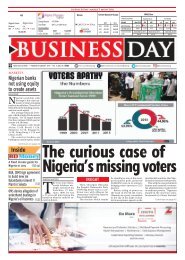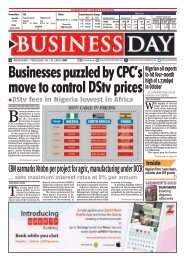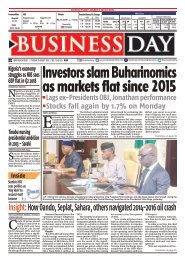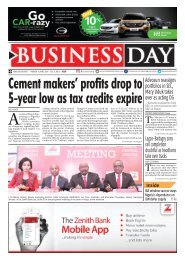BusinessDay 20 Jul 2017
Create successful ePaper yourself
Turn your PDF publications into a flip-book with our unique Google optimized e-Paper software.
Thursday <strong>20</strong> <strong>Jul</strong>y <strong>20</strong>17<br />
34 BUSINESS DAY<br />
C002D5556<br />
Read Ambitiously<br />
Smartphone makers<br />
join Apple’s battle<br />
against Qualcomm<br />
TRIPP MICKLE<br />
A<br />
group of leading smartphone<br />
manufacturers are<br />
joining Apple Inc. AAPL<br />
0.35% in a legal battle against<br />
Qualcomm Inc., QCOM -0.30%<br />
claiming that the chip maker<br />
charges excessive patent licenses<br />
and violates antitrust laws.<br />
Taiwan-based contract manufacturers<br />
Compal Electronics Inc.,<br />
2324 -0.48% Foxconn Technology<br />
Group, Pegatron Corp. 4938<br />
-0.51% , and Wistron Corp. 3231<br />
-0.33% planned to file a lawsuit<br />
against Qualcomm late Tuesday<br />
night in federal district court in<br />
San Diego, according to Theodore<br />
J. Boutrous, an attorney at Gibson,<br />
Dunn & Crutcher LLP who is representing<br />
the four.<br />
The companies, which assemble<br />
iPhones and iPads for<br />
Apple and other gadgets for other<br />
brands, are broadly challenging<br />
Qualcomm’s licensing practices<br />
with them as illegal, according to<br />
a draft copy of their complaint.<br />
Apple, which is covering legal<br />
fees associated with the manufacturers’<br />
defense, said it would<br />
file a separate motion Tuesday<br />
to consolidate the manufacturer’s<br />
countersuit and its own suit<br />
against Qualcomm.<br />
The planned moves come after<br />
a series of escalating legal blows<br />
between Apple and Qualcomm,<br />
which sells chips used in many<br />
smartphones and licenses technology<br />
used in nearly all of them.<br />
Apple sued Qualcomm in January<br />
in the U.S. claiming unfair<br />
business practices, and the four<br />
contract manufacturers—which<br />
have the direct licensing agreements<br />
with Qualcomm that cover<br />
iPhones and iPads—later stopped<br />
paying royalties on Apple’s behalf.<br />
Qualcomm sued the four in May<br />
over the nonpayment, setting up<br />
their planned countersuit Tuesday.<br />
Qualcomm has said that its licensing<br />
agreements with the contract<br />
manufacturers are independent of<br />
Apple. Qualcomm also has asked<br />
federal trade authorities to block<br />
imports of some iPhones and iPads<br />
as part of the broader dispute.<br />
Qualcomm says its licensing<br />
practices are fair, and that Apple<br />
is merely trying to reduce its costs<br />
at a time of slowing iPhone shipments.<br />
At a conference in Aspen<br />
Monday, Qualcomm Chief Executive<br />
Steve Mollenkopf said he expects<br />
the dispute to be settled out<br />
of court, just as Qualcomm settled<br />
a similar patent dispute in <strong>20</strong>08<br />
with cellphone maker Nokia Corp.<br />
ECB Chief Mario Draghi expected<br />
to reinforce tightening signals<br />
TOM FAIRLESS<br />
When European<br />
Central Bank<br />
chief Mario<br />
Draghi faces the<br />
media on Thursday<br />
after the bank’s latest policy<br />
meeting, he is expected to let<br />
stand his hint three weeks ago on<br />
a possible reduction of the ECB’s<br />
giant bond-buying program.<br />
Mr. Draghi had rocked financial<br />
markets into buying euros<br />
and selling euro bonds by indicating<br />
in a June 27 speech in Sintra,<br />
Portugal, that the bank would<br />
start slowly winding down the<br />
program, known as quantitative<br />
easing, which has underpinned<br />
eurozone financial markets since<br />
its launch in early <strong>20</strong>15.<br />
Few investors think he will<br />
signal a change in that course on<br />
Thursday. Most argue that the<br />
ECB needs to adjust its policy<br />
mix soon anyway, in response to<br />
an accelerating eurozone economy.<br />
Mr. Draghi’s speech late last<br />
month did part of the work in<br />
preparing financial markets for<br />
an imminent policy shift, they say.<br />
Any backtracking now “would<br />
only cause confusion and unwelcome<br />
volatility given that financial<br />
markets have already positioned<br />
themselves” for a policy change,<br />
said Marco Valli, an economist<br />
with UniCredit in Milan.<br />
Growth in the 19-nation bloc is<br />
expected to reach 3% in the second<br />
quarter on an annualized basis, the<br />
Where are the dips? The weird,<br />
unsettling rise of global stocks this year<br />
STEVEN RUSSOLILLO<br />
Stock markets go up and<br />
down: It is a fact of life. Except<br />
in <strong>20</strong>17.<br />
Three major stock-market<br />
benchmarks in the U.S., Europe<br />
and Asia have avoided pullbacks<br />
this year, commonly defined as 5%<br />
declines from recent highs. Never<br />
in at least the past 30 years have all<br />
three indexes—the S&P 500, MSCI<br />
Europe and MSCI Asia-Pacific<br />
ex-Japan—gone a calendar year<br />
without falling at some point by<br />
at least 5%.<br />
In good years and bad, markets<br />
tend to fluctuate wildly, with stock<br />
indexes often falling by doubledigit<br />
percentages before bouncing<br />
back. That hasn’t been the case<br />
this year, another reflection of the<br />
historically low volatility that has<br />
gripped the world. The CBOE Volatility<br />
Index, or VIX, finished Friday<br />
at its lowest since 1993.<br />
Of course, <strong>20</strong>17 is only a little<br />
more than half over, and plenty can<br />
change in the back half of the year.<br />
But the last time equity markets<br />
went this deep into a year without<br />
all three of those benchmark indexes<br />
suffering at least 5% pullbacks was<br />
nearly a quarter-century ago, in 1993,<br />
according to The Wall Street Journal’s<br />
Market Data Group. All three<br />
finished that year with sharp gains.<br />
Many investors say they are<br />
optimistic that the steady grind<br />
higher will continue and defy<br />
historical odds that suggest the<br />
markets should eventually falter.<br />
That is because earnings growth<br />
appears to be accelerating globally,<br />
economic growth is improving and<br />
central banks largely remain accommodative,<br />
even amid recent<br />
moves to tighten policy.<br />
The rise of quantitative trading<br />
and the flood of money into passive<br />
strategies such as exchange-traded<br />
funds have also dampened volatility,<br />
investors and strategists say.<br />
ETFs owned nearly 6% of the U.S.<br />
stock market in the first quarter, the<br />
highest share on record, according<br />
to an analysis of Federal Reserve<br />
data by Goldman Sachs .<br />
fastest pace in around a decade.<br />
Economic sentiment is close to a<br />
10-year high, unemployment is<br />
falling rapidly, and bank lending<br />
is picking up strongly, according<br />
to ECB data published on Tuesday.<br />
All that suggests the ECB can<br />
afford to take its foot off the gas.<br />
Its bond-buying program is currently<br />
due to run at €60 billion ($69<br />
billion) a month at least through<br />
December.<br />
“With the eurozone cyclical<br />
recovery going strong and the<br />
bank lending channel mostly<br />
unclogged, the floor is clear for<br />
Draghi to tiptoe slowly in the<br />
general direction of the exit on<br />
Thursday,” said Teunis Brosens,<br />
an economist with ING Bank in<br />
Amsterdam.<br />
Despite its initial reservations<br />
about QE, the ECB has proceeded<br />
aggressively, boosting its balance<br />
sheet to around $4.9 trillion—larger<br />
than the U.S. Federal Reserve’s.<br />
ECB officials have stressed that<br />
they will move very cautiously in<br />
winding down the program, wary<br />
of triggering an adverse market<br />
reaction that could upset the<br />
recovery. They have in mind the<br />
Federal Reserve’s policy error four<br />
years ago, when a hint that its own<br />
QE program would end triggered<br />
market turmoil around the world<br />
and a surge of more than 100 basis<br />
points in U.S. Treasury yields.<br />
Recent market movements<br />
in Europe, though, are probably<br />
acceptable to the world’s second-most<br />
powerful central bank,<br />
analysts say. German 10-year government<br />
bond yields have risen<br />
by about 30 basis points since<br />
Mr. Draghi’s speech last month,<br />
to around 0.6%. The euro is up<br />
around 4 cents against the dollar,<br />
hitting $1.1583 on Tuesday, its<br />
highest level in more than a year.<br />
Robots are replacing workers where you shop<br />
SARAH NASSAUER<br />
Last August, a 55-year-old<br />
Wal-Mart WMT -0.22%<br />
employee found out her<br />
job would now be done<br />
by a robot. Her task was to count<br />
cash and track the accuracy of<br />
the store’s books from a desk in<br />
a windowless back room. She<br />
earned $13 an hour.<br />
Instead, Wal-Mart Stores Inc.<br />
started using a hulking gray machine<br />
that counts eight bills per<br />
second and 3,000 coins a minute.<br />
The Cash360 machine digitally<br />
deposits money at the bank,<br />
earning interest for Wal-Mart<br />
faster than sending an armored<br />
car. And it uses software to predict<br />
how much cash is needed<br />
on a given day to reduce excess.<br />
“They think it will be a more<br />
efficient way to process the<br />
money,” said the employee, who<br />
has worked with Wal-Mart for a<br />
decade.<br />
Now almost all of Wal-Mart’s<br />
4,700 U.S. stores have a Cash360<br />
machine, turning thousands of<br />
positions obsolete. Most of the<br />
employees in those positions<br />
moved into store jobs to improve<br />
service, said a Wal-Mart spokesman.<br />
More than 500 have left the<br />
company. The store accountant<br />
is now a greeter at the front door,<br />
where she still earns $13 an hour.<br />
“The role of service and customer-facing<br />
associates will<br />
always be there,” said Judith<br />
McKenna, Wal-Mart’s U.S. chief<br />
operating officer, in an interview.<br />
But “there are interesting<br />
developments in technology<br />
that mean those roles shift and<br />
change over time.”<br />
Shopping is moving online,<br />
hourly wages are rising and retail<br />
profits are shrinking—a formula<br />
that pressures retailers from<br />
Wal-Mart to Tiffany & Co. to find<br />
technology that can do the rote<br />
labor of retail workers or replace<br />
them altogether.<br />
As Amazon.com Inc. makes<br />
direct inroads into traditional<br />
retail with its plans to buy grocer<br />
Whole Foods Market Inc., Wal-<br />
Mart and other large retailers<br />
are under renewed pressure to<br />
invest heavily to keep up.<br />
Economists say many retail<br />
jobs are ripe for automation. A<br />
<strong>20</strong>15 report by Citi Research, coauthored<br />
with researchers from<br />
the Oxford Martin School, found<br />
that two-thirds of U.S. retail jobs<br />
are at “high risk” of disappearing<br />
by <strong>20</strong>30.<br />
Self-checkout lanes can replace<br />
cashiers. Autonomous<br />
vehicles could handle package<br />
delivery or warehouse inventory.<br />
Even more complex tasks<br />
like suggesting what toy or shirt<br />
a shopper might want could be<br />
handled by a computer with<br />
access to a shopper’s buying<br />
history, similar to what already<br />
happens online today.


















